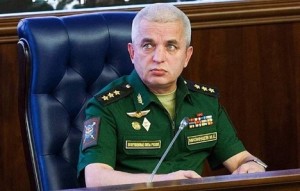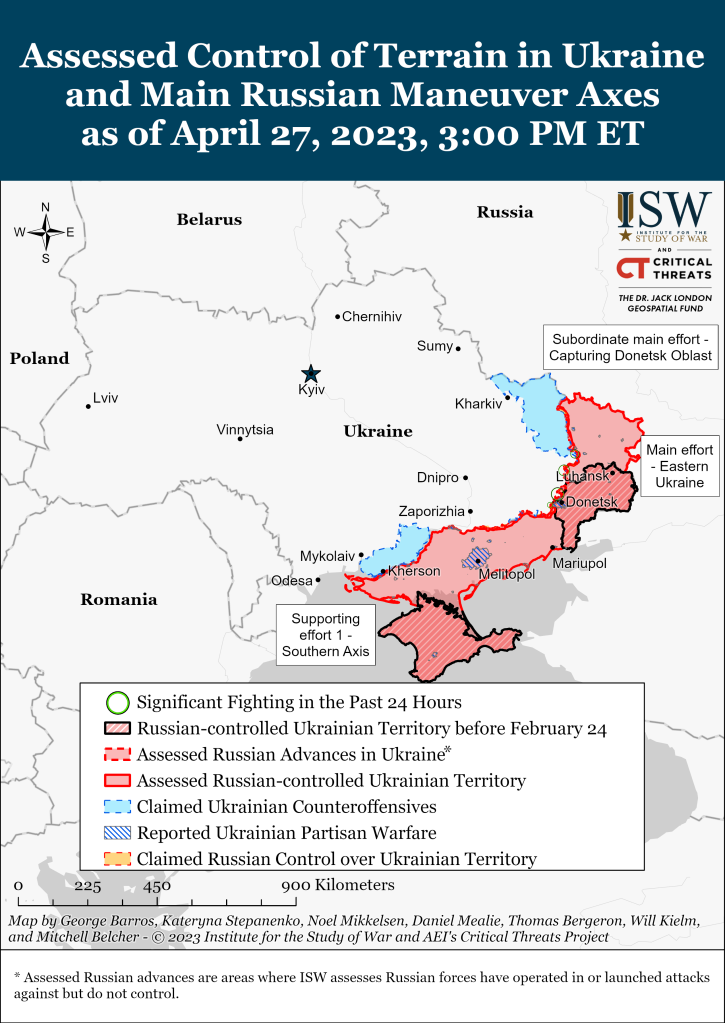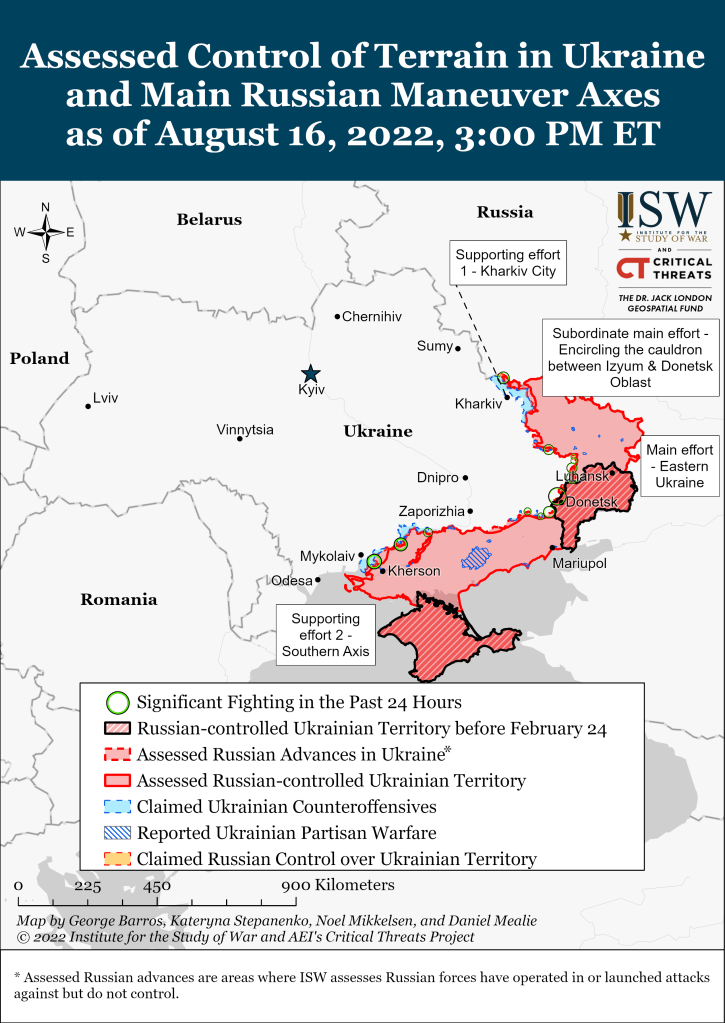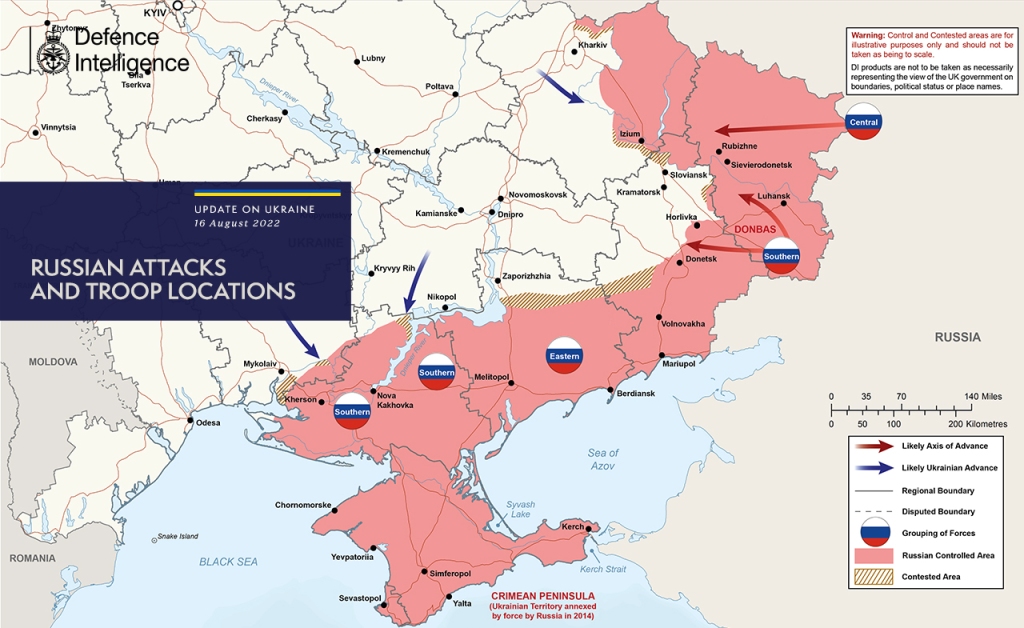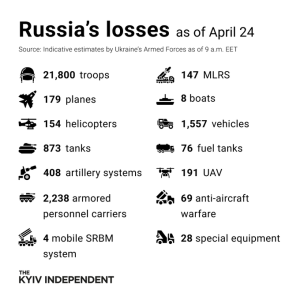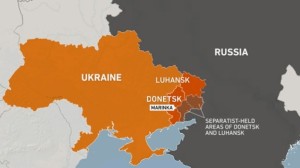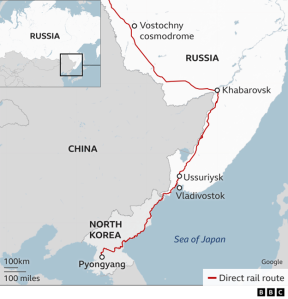 “I came, I promised to support your war, I left.” That paraphrase of Kim Jong Un’s visit with Russian president Vladimir Putin this week describes their bonhomie. Afraid of an air attack, the North Korean leader spent at least 40 hours on his luxury train, traveling about 37 mph from Pyongyang to the Vostochny Space Center before returning to safety.
“I came, I promised to support your war, I left.” That paraphrase of Kim Jong Un’s visit with Russian president Vladimir Putin this week describes their bonhomie. Afraid of an air attack, the North Korean leader spent at least 40 hours on his luxury train, traveling about 37 mph from Pyongyang to the Vostochny Space Center before returning to safety.
The massive green armored train is equipped with attack weapons and a helicopter for escape. Kim has used it for seven international trips, four of them to China, since he gained power in 2011. His father, Kim Jong Il, died on the train while on a “field guidance” visit. Nicknamed the “Moving Fortress,” the train has bulletproof windows and reinforced walls and floors to protect against explosives.
In a five-hour meeting with Putin, Kim promised “full and unconditional support” for him, apparently ignoring U.S. warnings not to arm Putin for his Ukrainian invasion. Putin wants Kim’s aging ammunition and rockets for Soviet-era weapons; Kim wants Russian help in developing military reconnaissance satellites to enhance his nuclear-capable missiles. After a failed second attempt last month to launch a military spy satellite, North Korea plans another try next month. From an examination of the debris, South Korea concluded the satellite’s technology is not sufficiently advanced to conduct space-based reconnaissance.
Buying arms from or providing rocket technology to North Korea violates international sanctions previously supported by Russia and increase Russian isolation, begun 19 months ago with Putin’s invasion of Ukraine. Hours before Kim’s meeting with Putin, North Korea fired two more ballistic missiles into waters off its East Coast outside the country’s economic zones, continuing distraction by Russia’s war to build his weapons’ development.
Last year, Russia used up to 11 million shells in Ukraine and plans to fire another seven million rounds this year. Putin’s officials claim that its relationship with North Korea isn’t an obstacle to Russia’s permanent membership on the UN Security Council. Russian Foreign Minister Sergei Lavrov indicated that Russia would continue to block continued sanctions resolution against North Korea, one of five countries declining to condemn Russia’s invasion and supporting Russia’s illegal takeover of Ukraine. Kim called it a “sacred struggle to defend its state sovereignty.”
According to hacked documents, Russia is recruiting over 100 male Cuban mercenaries for his war for “a one-time cash payment in the amount of 195,000 rubles,” about $2,000. Monthly payment would start at “204,000 rubles per month,” depending on rank, accompanied by spousal and family benefits. The hacked Russian officer didn’t deny his recruiting Cubans but responded to questions from Intercept with expletives and denouncing NATO and declaring “Russia will win.”
 Ukraine reported it retook control of four gas drilling platforms in the northern Black Sea, near the Crimean Peninsula. Russia had taken over the Boyko Towers in 2015, soon after it illegally annexed Crimea. Platforms command valuable hydrocarbon resources and are used for deployment, helicopter landing sites, and long-range missile systems positioning. Ukraine has been fighting for control of the northern Black Sea. Last year, Russia’s control of the platforms and Snake Island were seen as part of its threat to Ukraine’s Black Sea ports. Since then, Ukrainian drones and commandos launched raids on the northwestern Crimea, even planting a Ukrainian flat at a radar base on the Tarkankut Peninsula to mark Independence Day on August 24.
Ukraine reported it retook control of four gas drilling platforms in the northern Black Sea, near the Crimean Peninsula. Russia had taken over the Boyko Towers in 2015, soon after it illegally annexed Crimea. Platforms command valuable hydrocarbon resources and are used for deployment, helicopter landing sites, and long-range missile systems positioning. Ukraine has been fighting for control of the northern Black Sea. Last year, Russia’s control of the platforms and Snake Island were seen as part of its threat to Ukraine’s Black Sea ports. Since then, Ukrainian drones and commandos launched raids on the northwestern Crimea, even planting a Ukrainian flat at a radar base on the Tarkankut Peninsula to mark Independence Day on August 24.
This overview of the Russian invasion depicts it as a disaster from the beginning when 180,000 soldiers attacked five axes of advance, counting the axis toward Kherson oblast and advance toward Zaporizhzhia oblast in the south as separate ones. Advances toward Kyiv (Axis 1) failed and toward Kharkiv (Axis 2) was halted. Attempts to push through Ukraine’s fortified lines in Donbas (Axis 3) couldn’t move any line of defense. Only the southern ones succeeded by capturing Melitopol, Kherson, and Mariupol. Russian Chief of the General Staff Valery Gerasimov, the highest ranking soldier, then deployed troops to eastern Ukraine in an attempt to encircle Ukraine’s best brigades, a faltering plan that forced Gerasimov to scale down the size and number of forces.
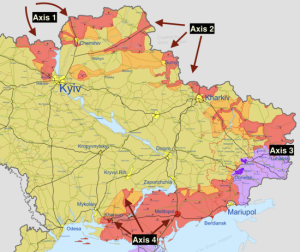 Russian gains in summer of 2022 were minimal with massive cost to its soldiers and equipment. By September 22, 2022, Ukraine liberated three vital rail hubs before trapping Russian forces in northern Kherson oblast and destroying two bridges supplying Russian occupation. The losses led Putin to appoint Colonel General Sergei Surovikin in charge. He withdrew troops from Kherson, abandoning equipment and ammunition that Ukraine could use, and refocused on the Donbas where Russia suffered more massive losses while Ukraine occupied the high ground. By November last year, Russia gained ground in isolated areas but failed to break Ukrainian resistance.
Russian gains in summer of 2022 were minimal with massive cost to its soldiers and equipment. By September 22, 2022, Ukraine liberated three vital rail hubs before trapping Russian forces in northern Kherson oblast and destroying two bridges supplying Russian occupation. The losses led Putin to appoint Colonel General Sergei Surovikin in charge. He withdrew troops from Kherson, abandoning equipment and ammunition that Ukraine could use, and refocused on the Donbas where Russia suffered more massive losses while Ukraine occupied the high ground. By November last year, Russia gained ground in isolated areas but failed to break Ukrainian resistance.
The West increased its supply of modern air defense systems, but Surovikin built layered defensive lines to prepare for Ukraine’s counteroffensive, anticipating Russian weakness. He assumed he could grind down Ukrainian forces, but Putin replaced him in January with Gerasimov. For the next six months, Russia faced costly and unsuccessful military engagements. One of them was capturing the city of Bakhmut, almost no gain to Russia. Under leader Yevgeny Prigozhin, the effective Wagner mercenaries, rebelled, partly against Gerasimov. He stayed and the Wagner troops, Gerasimov’s most successful tactical asset, were exiled to Belarus. Surovikin, accused of helping the rebellion, was assigned to a backwater post for disgraced generals.
Gerasimov abandoned Surovikin’s defense-in-depth strategy: instead of defending Russian gains with well-placed defensive lines, he moved reserves intended to plug potential breeches to the front lines. Another Gerasimov mistake was putting the vast majority of his landmines in the first line of defense, making his success only temporary. Gerasimov consistently overestimated Russian military capabilities and underestimated those of Ukraine.
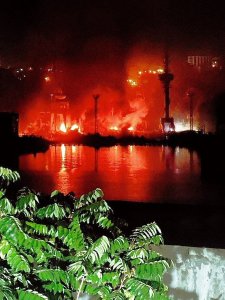 This week, Ukrainian missiles hit a shipyard in Russia-annexed Crimea, also destroying a fuel tank and injuring 24 people. Two Russian navy ships were engulfed in flames, and a large Russian landing ship and a submarine were damaged beyond repair. The facility not only builds ships and submarines for the Black Sea Fleet but also repairs them. Some of this week’s explosions and other events, including Russia’s shortage of diesel fuel, is here.
This week, Ukrainian missiles hit a shipyard in Russia-annexed Crimea, also destroying a fuel tank and injuring 24 people. Two Russian navy ships were engulfed in flames, and a large Russian landing ship and a submarine were damaged beyond repair. The facility not only builds ships and submarines for the Black Sea Fleet but also repairs them. Some of this week’s explosions and other events, including Russia’s shortage of diesel fuel, is here.
Unable to make transactions in U.S. dollars, Russia has severely limited its trade. Billions of its oil sale profits are trapped in Indian banks, and other commodities such as gold and wheat require the U.S. dollars. An attempt to switch to the Chinese yuan and Indian rupee has backfired because of India’s restrictions preventing the transfer of rupees to Russian rubles, as much as $39 billion, because of Russia’s unstable financial situation. Russia’s only current option is to spend the billions in India or invest it there, but India is selling very little to Russia.
Despite Russia’s embargo on grain ships leaving Ukraine, “ghost ships” have taken their place, transporting grain from occupied eastern Ukraine via the sanctioned Port of Sevastopol in Crimea, using the Kerch Strait with ship-to-ship transfers. Several of these were shown on ship monitoring services, but that went dark for at least one ship on June 16. A tracker found a ship matching the missing one being loaded outside a grain terminal, but it disappeared a few days later, reappearing in Turkey and moving on to Iran. Investigations by several media groups found grain being exported in at least ten ships although Russia denied it with Syria as a destination.
Once again, the Kremlin’s party and candidates won a highly controlled election in Russia-occupied Ukraine by a large majority for the second time. The atmosphere was silent. In Russia, the Kremlin also won with several leading opposition figures sentenced to long-prison terms.
 In a happy ending, Yampil the bear, rescued from a zoo in the Donetsky region after Russians killed about 200 animals, will find a home at Five Sisters Zoo in Scotland. The Asian black bear was found hiding in the wreckage, his caretakers long gone, a year ago. Emaciated from lack of food, he had been concussed from a shell exploding nearby and seemed close to death. Volunteers who discovered him named him Yampil after the village where he was found put him into a truck and drove him to safety. Veterinarian Romain Pizzi called him a gentle giant with a calm, cautious personality and “big sort of Mickey-Mouse ears.”
In a happy ending, Yampil the bear, rescued from a zoo in the Donetsky region after Russians killed about 200 animals, will find a home at Five Sisters Zoo in Scotland. The Asian black bear was found hiding in the wreckage, his caretakers long gone, a year ago. Emaciated from lack of food, he had been concussed from a shell exploding nearby and seemed close to death. Volunteers who discovered him named him Yampil after the village where he was found put him into a truck and drove him to safety. Veterinarian Romain Pizzi called him a gentle giant with a calm, cautious personality and “big sort of Mickey-Mouse ears.”
Yampil the village was liberated from Russian occupation in late September 2022 in a Ukrainian counteroffensive capturing key cities in the region. The bear was first taken to a Polish zoo and then to a Belgian wildlife rehabilitation center which had previously sent brown bears to the Five Sisters Zoo. Pizzi was concerned about Yampil’s mental health but found him resilient. The zoo will finish the bear’s enclosure in early 2024 where he may live for another 20 years. (Above, left: Yampil in his temporary Belgian home.)
Five Sisters Zoo is raising £200,000 for Yampil’s new habitat. Ten percent of each donation goes to his temporary home at Natuur Hulp Centrum. Opened in 2005 between Edinburgh and Glasglow, Five Sisters Zoo has over 180 different species from around the world.


